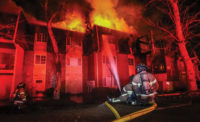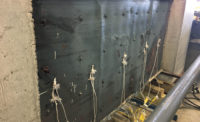Six months after an explosion and fire destroyed a grid-connected energy-storage battery facility in Surprise, Ariz., investigators are still trying to figure out all that happened. The incident sent eight firefighters and a police officer to the hospital, and three required extended stays.
What happened at the Arizona Public Service Co. site was a shocking reminder of the potential fire hazards of lithium-ion battery energy storage, which makes up virtually all such new systems in the U.S.
This was not the utility’s first fire experience. Following a 2012 blaze at another battery storage facility, Arizona Public Service applied lessons from that failure as it continued to add stationary storage for its renewable energy fleet.
Storage is a major part of the utility’s plans. In February 2019 Arizona Public Service announced that it intended to add 850 MW of solar storage and standalone battery storage to its system’s existing 6 MW of battery storage by 2025. The storage program is part of a long-term clean energy transition in which renewable and storage technologies will play an increasingly important role, utility officials say.
|
Related Article |
The fire issues with battery storage are also important to the future of renewable energy across the U.S. Electricity must be generated at the instant it is needed. Fossil-fueled power plants store coal or natural gas to generate power on demand, but solar and wind farms require battery storage. “Large-scale battery storage is a critical step on the path to reliable and affordable clean-energy solutions,” said Pat Graham, Arizona state director of the Nature Conservancy.
This month’s award of the Nobel Prize in chemistry to three scientists who developed the lithium-ion battery recognized its revolutionary energy storage significance, with the rechargeable battery now used for applications from pocket-sized consumer electronics to grid-connected renewable power.
What it will take to solve the fire problem isn’t clear yet. But in an Oct. 10, 2019, update in Greentech Media, part of energy research firm Wood Mackenzie, the writer concludes that the April explosion has prompted a re-evaluation of lithium-ion battery fire safety that will require a change in conventional battery safety engineering, based on interviews with Arizona Public Service and Fluence, the system integrator.
George Crabtree, director of Argonne National Laboratory’s Joint Center for Energy Storage Research, says the challenge arises when lithium-ion battery temperature goes above 150° C. “A reaction takes place between the cathode and the electrolyte that doesn’t require any oxygen from the air to proceed. It has everything it needs right there, and that reaction releases heat,” he says.
The released heat raises the temperature of the battery, speeding the reaction until it is in “thermal runaway,” says Crabtree.
Some commenters on the Greentech Media article related their efforts to find lithium-ion battery alternatives that are safe, durable, efficient and high in energy density. They debated the pros and cons of alternative battery chemistries and the ready market availability of their components—and their costs.
Other comments suggested that changing the design of cell clusters and modules, improving interior layout to limit effects of thermal runaway, installing better ventilation to reduce the concentration of explosive gases and other upgrades could reduce potential hazards.
In September, the National Fire Protection Association released NFPA 855, Standard for the Installation of Stationary Energy Storage Systems, the first comprehensive collection of criteria for the fire protection of energy storage systems.
Among other things, the standard addresses the setting where the technology is being installed, the size and separation of energy storage installations, and the fire suppression and control systems that are in place.
Those safety measures will be important because the basic hazard in the battery chemistry and heat remains. Or as Crabtree says, “So far, no one’s been able to figure it out.”





Post a comment to this article
Report Abusive Comment